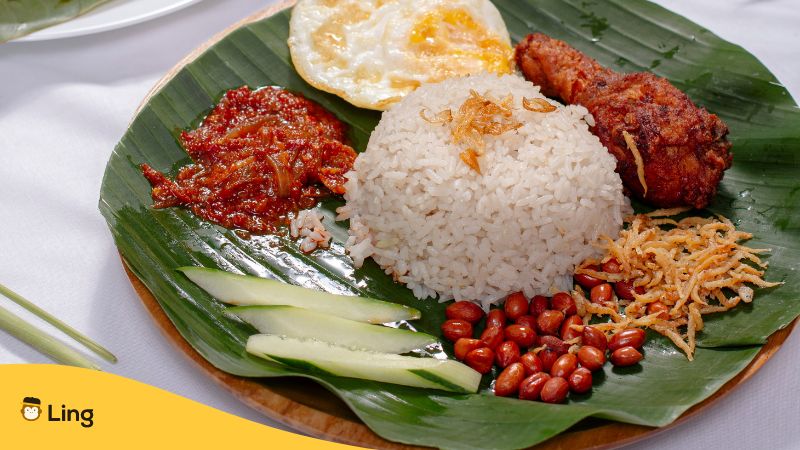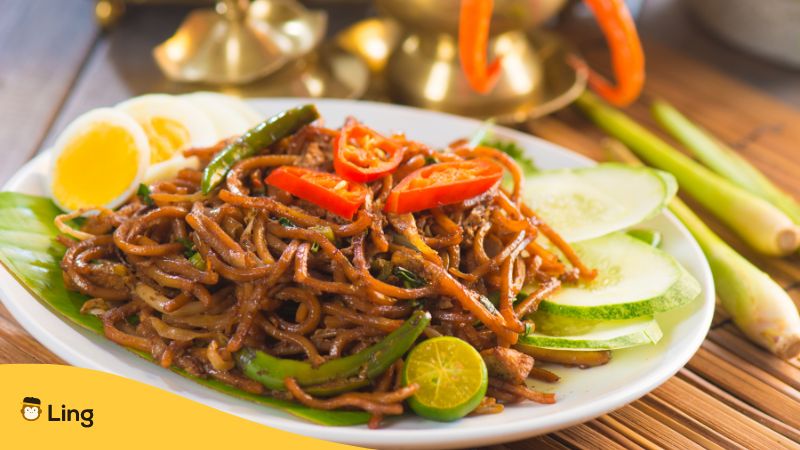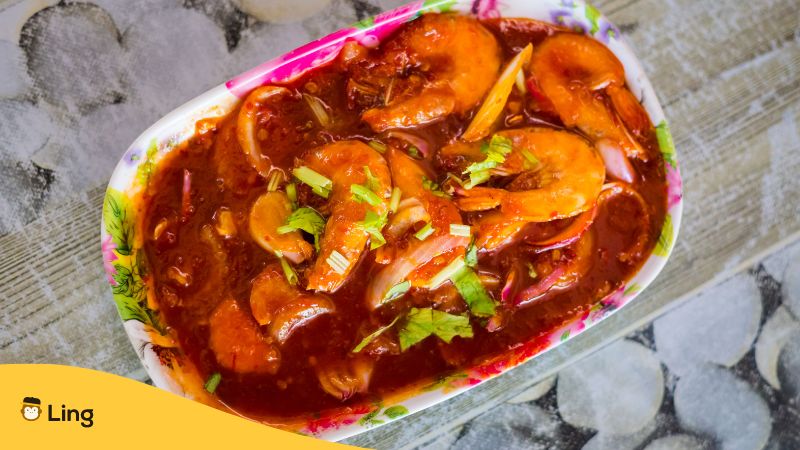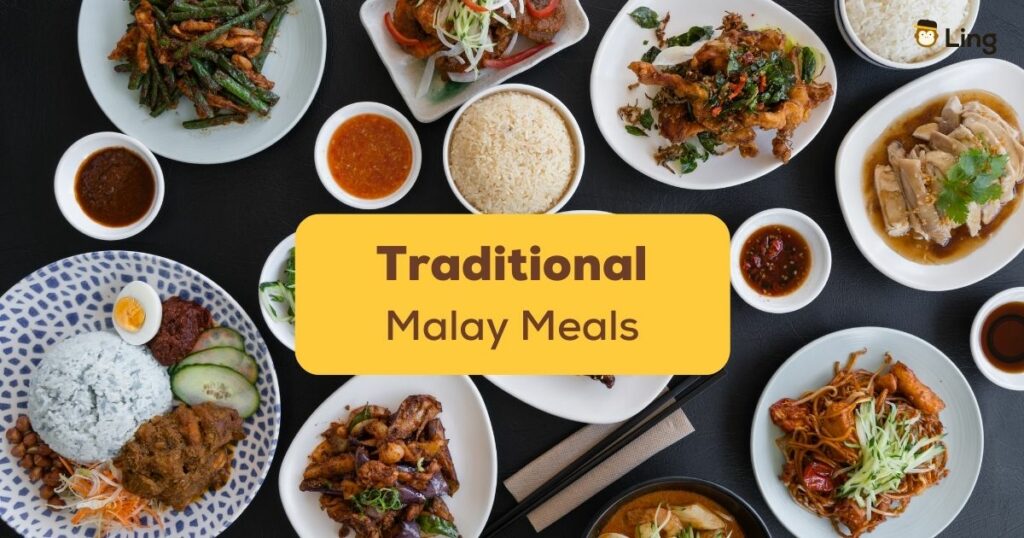Makan just like a local with this ultimate guide to traditional Malay meals! We’re listing some of the most popular Malaysian food items locals love. These foods are as rich in history as they are in flavor, and we are so excited to show you all of them!
We’ll cover the food’s origins, ingredients, preparations, and regional variations. It’s going to be delectable – we hope you’re hungry!
Traditional Malay Meals – The Best Of Malaysian Food In One List
1. Nasi Lemak

Nasi Lemak is considered to be Malaysia’s national dish and is a beloved staple of Malaysian cuisine. The dish’s fascinating history reflects the multicultural influences that have shaped Malaysia’s food culture. The dish’s name comes from two Malay words: “nasi,” which means rice, and “lemak,” which means creamy or fatty, referring to using coconut milk for cooking the rice.
It was initially a humble breakfast dish eaten by farmers and fishermen who needed a filling meal to sustain them through their work. In its simplest form, nasi lemak is rice mixed with coconut milk, steamed, and served with deep-fried anchovies, tomatoes, and cucumbers. The dish was traditionally served wrapped in a banana leaf, which helped to keep the rice warm and moist.
Nasi lemak has become a popular street food in Malaysia and has spread to other parts of Southeast Asia. The dish has evolved to include a variety of side dishes, such as fried chicken wings, egg, and sambal, a spicy chili paste. Today, nasi lemak is served not only as a breakfast dish but also as a meal at any time of the day and is available in various settings, from street food stalls to high-end restaurants.
2. Rendang
Rendang is a rich and flavorful meat dish that is popular in Malaysia, as well as in other parts of Southeast Asia. As a recipe, Rendang is believed to have originated in Indonesia, particularly in the Minangkabau region of Sumatra. The Minangkabau people have a long history of cattle farming, and Rendang was originally a way of preserving meat in a tropical climate before the advent of refrigeration.
With the two countries sharing similar climates, it quickly made its way to Malaysian cuisine, becoming one of its most popular dishes. In Malaysia, Rendang is often made with beef but can also be made with chicken, lamb, or goat.
The dish is made by simmering the meat in a rich and flavorful sauce made with a blend of herbs and spices, including lemongrass, galangal, turmeric, ginger, garlic, and chilies, with coconut milk for a creamy texture. The sauce is cooked until thick and almost dry, creating a rich and intense flavor.
Rendang is considered traditional food and is commonly eaten on special occasions, such as weddings, festivals, and other celebrations. It is often served with steamed rice and other side dishes, such as fried chicken, vegetables, and sambal.
3. Satay
When it comes to Malaysian food, one of the most popular has to be satay. It comes from the root word, sate, which means skewer. In popularity, this even rivals nasi lemak as the national dish!
Satay is a popular dish in Malaysia that consists of skewered and grilled meat, usually chicken, beef, or lamb, served with a spicy peanut sauce and cucumber chunks. The dish’s long and fascinating history reflects the region’s diverse cultural influences.
The origins of Satay are believed to have been in Java, Indonesia, and spread throughout Southeast Asia over time. The dish was originally made with chunks of meat marinated in a blend of herbs and spices, then skewered and grilled over an open flame.
In Malaysia, Satay has become a beloved street food, often sold by vendors who grill the meat over charcoal on portable grills. The meat is typically served with a spicy peanut sauce made by blending peanuts, chili, and other ingredients and is often accompanied by cucumber, onion, and ketupat, a compressed rice cake made with glutinous rice.
In recent years, there has been a trend towards experimenting with different types of meat, such as venison, rabbit, and even fish, to create new and exciting flavors of Satay.
4. Laksa
Laksa is a famous spicy noodle soup that is a beloved dish in Malaysia and Southeast Asia. It is believed to have originated in the Peranakan community, a blend of Chinese and Malay cultures developed in Malaysia and Singapore’s coastal regions. The dish was created as a fusion of Chinese cuisine and Malay flavors and incorporates a blend of herbs, spices, and noodles.
There are many different types of Laksa, but the two most popular varieties are Asam Laksa and Curry Laksa. Asam Laksa is made with a sour and spicy fish-based broth, tamarind, lemongrass, and galangal. It is typically served with rice noodles, cucumber, and mint. On the other hand, Curry Laksa is made with a rich and creamy coconut cream-based broth, curry powder, and spices and is typically served with egg noodles, chicken, shrimp, bean sprouts, and tofu.
Laksa is best eaten at a hawker stall and at night, either as dinner or as an after-hours meal. It is often sold by street vendors, who prepare the broth and noodles on the spot, and can also be found in restaurants and cafes. This noodle dish served as one of the best contributions of Malaysian cuisine to the world!
5. Mee Goreng

Mee Goreng is a delectable and savory stir-fried noodle dish with all the hallmarks of Malaysian dishes: savory, spicy, and toppings! It is a combination of mee (noodles) and goreng (fried). As simple as it sounds, this noodle dish has much more to offer.
They are fried noodles served with vegetables such as onions, tomatoes, bean sprouts, and chilies, combined with proteins such as minced meat, chicken, prawns, and tofu. A sweet, spicy sauce is added, typically consisting of soy sauce, chili sauce, tomato ketchup, and more! Finally, the dish is topped with fresh lime, cucumbers, and fried shallots for an extra burst of flavor and texture.
It is commonly eaten with a fried egg on top, along with roasted peanuts and a nice, cold drink! Mee goreng is a Malaysian dish that has earned a good reputation worldwide.
6. Nasi Ayam
Nasi Ayam (translated as chicken rice) consists of steamed or roasted chicken served with fragrant rice and various flavorful condiments – Malaysian food’s take on chicken fried rice. It is rooted in Hainanese cuisine, from Hainan migrants to Malaysia in the early 20th century. These immigrants brought their own culinary traditions, including a steamed chicken dish served with rice, vegetables, and a flavorful dipping fish sauce.
Over time, the dish evolved to reflect Malaysian food’s local tastes and ingredients. Today, Nasi Ayam typically consists of chicken marinated in a blend of herbs and spices, then steamed or roasted until tender and juicy.
The chicken is then served with fragrant rice, which has been cooked in chicken broth and flavored with ginger, garlic, and other spices. Other common condiments include soy sauce, chili sauce, and a tangy, sweet-sour dipping sauce made with garlic, ginger, vinegar, or lime juice. Despite its richness, nasi ayam is available everywhere, from hawker stalls to casual restaurants.
7. Otak-otak

Otak-otak is a popular dish in Malaysia and other parts of Southeast Asia, consisting of a type of fish cake grilled or steamed in banana leaves. Its name comes from the Malay word otak (brain), owing to the brain-like texture of the dish. Despite its looks and menacing name, it still has a fascinating history that reflects the region’s diverse cultural influences.
It is believed to have originated in Indonesia and then spread to Malaysia and other parts of Southeast Asia. The dish was likely created to preserve fish and other seafood, which was abundant in the coastal regions.
The traditional recipe for otak-otak typically consists of a mixture of fish or seafood, coconut milk, spices, and herbs, which is then wrapped in a banana leaf and grilled or steamed until cooked. The result is a fragrant and flavorful fish cake that is both rich and savory, with hints of a banana leaf poking through!
Over time, otak-otak has evolved to incorporate various ingredients, including shrimp, squid, and even chicken. It is often served with a spicy chili sauce or a sweet and sour dipping sauce and can be enjoyed as a snack or a main dish.
8. Kway Teow
While not indigenously Malay, kway teow (which means shredded flat rice noodles in Hokkien) is considered one of the most popular Malaysian dishes, and many Southeast Asian countries agree.
It originates from Southern China, brought by Hokkien migrants through sea trade. While it has changed quite a lot from the rice noodles that Chinese Malays of old used to have, it still carries the same ingredients: the noodles, the protein, and a healthy serving of vegetables.
In Malaysia, kway teow is typically stir-fried with soy sauce, chili paste, shrimp paste, garlic, and fried bean curd. It is also topped with proteins such as shrimp, chicken, or beef. Some people prefer to eat it with a fried egg on top! It is often served with a side of clear hot soup and a serving of sambal.
9. Sambal Udang

Seafood lovers will find themselves in love with this delectable dish! Sambal udang is a spicy shrimp dish in Malaysia and other countries in Southeast Asia. It comprises two words: sambal, which you know as a chili sauce used in Malaysian food, and udang, which means “shrimp.”
The dish consists of shrimp marinated in a mixture of spices, including dark soy sauce and palm sugar, and then stir-fried in the spicy-savory sambal. Other ingredients, such as vegetables and herbs, are added depending on which region you get this Malaysian food from!
It is often served with steamed rice and noodles and eaten on banana leaves. There may be a variety of dipping sauces as well, depending on the region!
10. Curry Mee
The perfect dish for a rainy night? This standout of Malaysian food might be the one for you. Curry mee (noodles) is a popular noodle soup in Malaysia, made with yellow noodles and vermicelli noodles, served in a curry-based broth—yes, our mouths are watering, too.
To top it off, we have some bean curd, bean sprouts, proteins such as chicken, shrimp, or fish, and long beans. For a more sinful version: runny, soft-boiled eggs. Some people go the extra mile with pork blood cubes, deep-fried pork skin, or juicy fish balls. Malaysian food is all about excess!
Its origins are steeped in Malaysia’s Indian Muslim community. Depending on the region, sometimes you may see this Malaysian food substituted with thick rice noodles, have roti canai on the side, or be a bit more spicy than usual.
11. Kuih Seri Muka
Of all the Malaysian food we’ve discussed today, this one has the most beautiful name. Kuih means “sweet”, while seri muka means “beautiful face.” It’s an apt name for such a lovely dessert!
Kui seri muka is essentially a type of green rice flour jelly made with glutinous rice flour soaked in water and mixed with coconut milk and pandan juice before being steamed. It is then topped with a coconut custard made with coconut milk, pandan leaves, and palm sugar. Finally, the whole thing is steamed once more to let the custard set.
It is then cut into small, bite-sized pieces, sometimes wrapped in banana leaves, and served as a sweet snack or dessert. Most Malaysian food stalls would have it, with some variants topped with condensed milk or sweet syrup. It is traditionally served during Hari Raya or Chinese New Year as well.
Learn All About Malay Words (And Malaysian Food) With Ling App

We hope you enjoyed this little taste of Malaysia! We’re sure you’re rushing to book your tickets now, but what if you learned the Malay language before your trip? Wouldn’t it be nice to truly immerse yourself in a foreign culture?
If the answer to the questions above is “yes,” then the Ling app is for you! It’s equipped with thousands of lessons in the Malay language and 60+ more languages, all optimized to make learning fun, engaging, and memorable!
Get started on learning Bahasa Melayu today with Ling app through your Android or iPhone.







